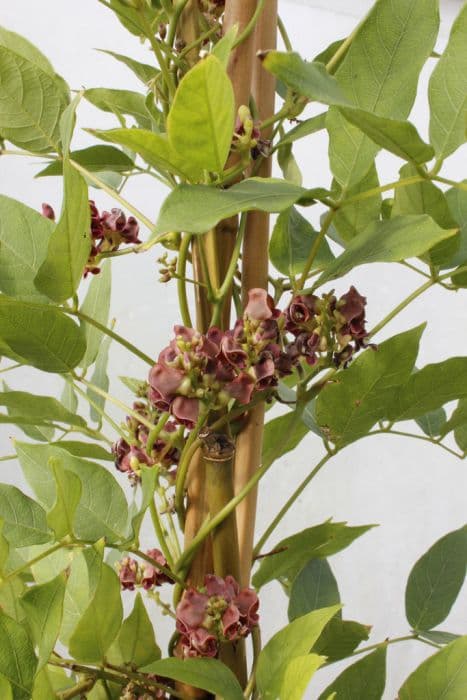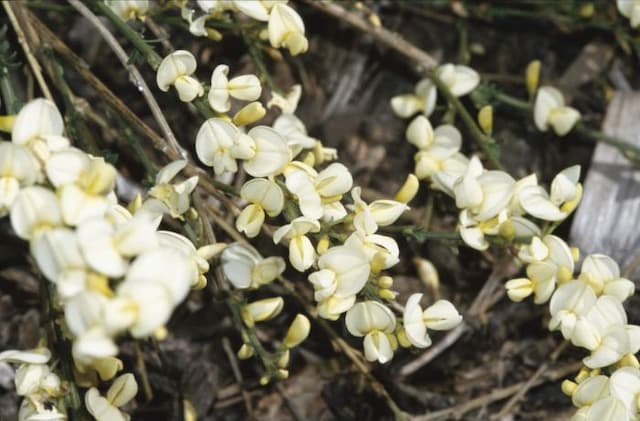Weeping Peashrub Caragana arborescens 'Pendula'

ABOUT
Caragana arborescens 'Pendula', commonly known as the Weeping Peashrub, is an ornamental plant noted for its unique and attractive growth habit. The most distinctive feature of this shrub is its weeping form, with branches that droop gracefully downwards, creating a striking cascading effect. It bears small, compound leaves that are made up of multiple leaflets, each one delicate and charming with a bright green hue that adds to the plant's overall feathery texture. During the spring season, the Weeping Peashrub becomes even more appealing as it produces a profusion of bright yellow, pea-like flowers. These blossoms are small but numerous, often covering the arching branches and providing a sunny spectacle that contrasts beautifully with the foliage. After the flowering period, small, seed-bearing pods may develop, which are typical of plants in the pea family. Its bark has a greenish to brownish color, which can become more textured and rugged as the plant matures. The overall visual effect of the Weeping Peashrub makes it a favorite for those seeking to add an element of softness and movement to their garden landscapes.
About this plant
 Names
NamesFamily
Fabaceae
Synonyms
Weeping Peashrub, Weeping Siberian Peashrub, Walking Stick Caragana, Pendant Peashrub
Common names
Caragana arborescens 'Pendula'.
 Toxicity
ToxicityTo humans
The Weeping Peashrub is not widely recognized as a poisonous plant to humans. However, ingesting any plant material can potentially cause mild stomach upset due to the presence of certain plant compounds. No severe toxicity or symptoms specific to the ingestion of Weeping Peashrub are commonly reported.
To pets
The Weeping Peashrub is not considered highly toxic to pets, but as with humans, the ingestion of plant material may cause mild gastrointestinal upset in some animals. If a pet consumes a large amount of the plant, symptoms like vomiting or diarrhea may occur. It is always a good practice to prevent pets from ingesting ornamental plants.
 Characteristics
CharacteristicsLife cycle
Perennials
Foliage type
Deciduous
Color of leaves
Green
Flower color
Yellow
Height
6 feet (1.8 meters)
Spread
4 feet (1.2 meters)
Plant type
Shrub
Hardiness zones
2
Native area
Siberia
Benefits
 General Benefits
General Benefits- Ornamental Value: Caragana arborescens 'Pendula', also known as the Weeping Peashrub, boasts pendulous branches and an elegant weeping form, making it a visually attractive focal point in the landscape.
- Drought Tolerance: Once established, this hardy shrub is drought-resistant, making it suitable for dry climates and low-water gardens.
- Cold Hardy: The Weeping Peashrub is well-suited for cold climates, being able to withstand temperatures down to USDA Zone 2.
- Soil Adaptability: It can grow in a range of soil types, from well-drained sandy soils to heavy clays, as long as there is adequate drainage.
- Wildlife Attraction: The plant's flowers can attract pollinators such as bees, while the seeds may provide food for birds, contributing to biodiversity in a garden setting.
- Windbreak and Erosion Control: Its dense growth habit and deep root system help to reduce wind speed and prevent soil erosion, especially in rural or open landscapes.
- Low Maintenance: The Weeping Peashrub requires minimal care once established, needing only occasional pruning to maintain shape and remove any dead wood.
 Medical Properties
Medical PropertiesThis plant is not used for medical purposes.
 Air-purifying Qualities
Air-purifying QualitiesThis plant is not specifically known for air purifying qualities.
 Other Uses
Other Uses- The weeping pea shrub's flexible branches can be woven into baskets and other crafts, offering a natural and sustainable material for artisans.
- Due to its dense foliage, the weeping pea shrub can be used as a privacy screen in gardens, efficiently creating secluded areas within a landscape.
- Its wood, being fairly hard and durable, can be utilized in the creation of small wooden objects such as tool handles or carved ornaments.
- The plant can act as a windbreak when planted in rows, protecting gardens and crops from strong winds and aiding in soil erosion control.
- With proper training and shaping, the weeping pea shrub can be turned into a living fence, both decorative and functional for delineating property boundaries.
- During the winter, the plant's silhouette adds architectural interest to barren gardens, offering an aesthetic value beyond the growing season.
- Its drought resistance makes it an ideal plant for xeriscaping, which involves creating landscapes that reduce or eliminate the need for irrigation.
- The seeds of the weeping pea shrub, although not commonly consumed, can be used as a fodder for livestock, especially in times of scarcity.
- It can be implemented in phytoremediation strategies to help stabilize soil and remediate contaminated sites thanks to its tolerance of harsh conditions.
- The plant's nitrogen-fixing ability enhances soil fertility naturally, making it beneficial for intercropping in agricultural practices and organic gardens.
Interesting Facts
 Feng Shui
Feng ShuiThe Weeping Peashrub is not used in Feng Shui practice.
 Zodiac Sign Compitability
Zodiac Sign CompitabilityThe Weeping Peashrub is not used in astrology practice.
 Plant Symbolism
Plant Symbolism- Resilience: Caragana arborescens, commonly known as the Siberian Peashrub, often symbolizes resilience as it can thrive in tough, cold climates, which speaks to its ability to persevere through challenging conditions.
- Protection: In landscaping and garden design, the Siberian Peashrub is sometimes used as windbreaks or hedges, which can represent protection and shelter.
- Renewal: As a deciduous shrub, it sheds its leaves in the fall and grows new ones in the spring, representing new beginnings and renewal.
- Adaptability: The Siberian Peashrub's ability to adapt to various soil types and environments signifies adaptability and versatility.
 Water
WaterThe Weeping Peashrub should be watered deeply enough to saturate the root zone, which generally means applying around 2 gallons for younger plants and up to 10 gallons for established trees, depending on size and soil conditions. The watering frequency should be adjusted according to the climate and soil drainage, but on average, once a week during the growing season and less frequently during the dormant period is sufficient. Overwatering can be as detrimental as under-watering, so ensure the soil is moist but not waterlogged. In extremely hot temperatures or during dry spells, increase watering frequency to prevent stress.
 Light
LightThe Weeping Peashrub thrives in full sun to partial shade, with a preference for a location that offers at least six hours of direct sunlight per day. While it can tolerate partial shade, it will produce the most lush growth and best flowering in full sun exposures.
 Temperature
TemperatureThe Weeping Peashrub is quite hardy and tolerates a wide range of temperatures; however, it grows best within a range of 60 to 75 degrees Fahrenheit. It can survive winter cold down to -40 degrees Fahrenheit, making it suitable for many climates.
 Pruning
PruningPruning the Weeping Peashrub is essential to maintain its shape, remove any dead or damaged branches, and promote healthy growth. The best time to prune is in late winter or early spring before new growth starts. Light pruning can be done annually, while a more thorough shaping should only be necessary every few years.
 Cleaning
CleaningAs needed
 Soil
SoilWeeping pea requires well-drained, loamy soil with a pH of 6.0 to 7.5. Amend the soil with organic matter and ensure it is not too wet, as this can lead to root rot.
 Repotting
RepottingWeeping peas, being a larger shrub, are not generally repotted. In landscape use, they do not require repotting but may need transplanting if they outgrow their space.
 Humidity & Misting
Humidity & MistingWeeping pea is tolerant of a wide range of humidity levels and does not have specific humidity requirements.
 Suitable locations
Suitable locationsIndoor
Weeping pea thrives best outdoors; growth indoors is not recommended.
Outdoor
Plant in well-drained soil, full sun, shelter from strong winds.
Hardiness zone
2-7 USDA
 Life cycle
Life cycleThe life of the weeping pea shrub (Caragana arborescens 'Pendula') begins with seed germination, where conditions of warmth and moisture encourage the development of a root system and sprouting shoots. The seedling stage involves the establishment of a small stem and initial leaves which, with proper nutrients and light, will develop into a young plant. As the plant enters its vegetative growth phase, it focuses on producing more leaves and branches, building a stronger root system, and reaching for sunlight. After a few years, the plant matures and enters the reproductive stage, producing yellow pea-like flowers in late spring, which are followed by seed pods that mature by summer's end. These seeds, once dispersed, can lead to new plants, continuing the cycle. Throughout its life, the weeping pea shrub may undergo pruning, shaping, and in some cases grafting, to maintain its distinctive pendulous form.
 Propogation
PropogationPropogation time
Late winter to early spring
Caragana arborescens 'Pendula', commonly known as Weeping Peashrub, is most effectively propagated by softwood cuttings. This is typically carried out in late spring or early summer when new growth is still tender and flexible. A cutting should be taken from a healthy branch, ideally 4 to 6 inches (approximately 10 to 15 centimeters) long, and trimmed just below a node. The leaves on the lower half of the cutting are removed to prevent moisture loss. It's then recommended to dip the cut end in a rooting hormone to encourage root development. Finally, the prepared cuttings are placed in a well-draining potting mix, ensuring that at least one node is buried where the roots will form. The environment should be kept humid, which can be accomplished by covering the cuttings with a plastic bag or placing them in a propagation chamber, and within a few weeks, the cuttings should start to root.








